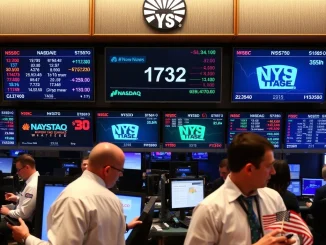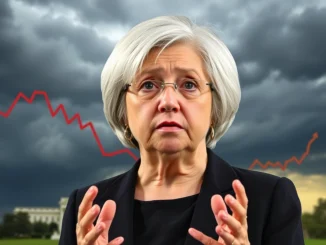
Navigating the turbulent waters of the global economy can feel like riding a rollercoaster, especially for those invested in the dynamic world of cryptocurrencies. Recent pronouncements from U.S. President Donald Trump regarding tariffs and potential recession have sent ripples through traditional markets, and these waves inevitably lap at the shores of the crypto sphere. Let’s dive into the latest developments and understand what they could mean for you.
Why is Trump Defending Tariffs?
In a recent meeting with top U.S. business leaders on March 11, President Trump doubled down on his administration’s trade policy, specifically defending the imposition of tariffs. According to reports from Reuters, Trump stated that these tariffs are set to generate substantial revenue for the United States. He even hinted at the possibility of further escalating these tariffs, signaling a continued aggressive stance on trade.
Here’s a breakdown of Trump’s key points on tariffs:
- Revenue Generation: Trump emphasized that tariffs are bringing in significant money for the country.
- Potential Increase: He suggested that tariffs might be raised even higher, indicating a flexible and potentially escalating approach to trade.
- Rebuilding the Country: Trump linked tariffs to a broader goal of rebuilding the U.S. economy, suggesting a long-term strategic vision behind these measures.
This unwavering defense of tariffs comes at a time when global economic uncertainty is already heightened. But what exactly are the intended benefits, and are there potential downsides to this strategy?
The Rationale Behind Tariffs: Benefits and Challenges
Tariffs, essentially taxes on imported goods, are designed to protect domestic industries by making imported products more expensive. The Trump administration’s justification often revolves around:
- Protecting American Jobs: By making imports pricier, domestic goods become more competitive, theoretically boosting local production and employment.
- Reducing Trade Deficits: Tariffs aim to discourage imports, thereby narrowing the trade deficit.
- National Security: In certain sectors like steel and aluminum, tariffs are argued to be essential for maintaining domestic production capabilities crucial for national security.
However, the implementation of tariffs is not without its challenges and potential repercussions:
- Increased Costs for Consumers: Tariffs can lead to higher prices for imported goods, which are often passed on to consumers.
- Retaliation from Trading Partners: Imposing tariffs can provoke retaliatory tariffs from other countries, leading to trade wars that harm multiple economies.
- Supply Chain Disruptions: Businesses relying on imported components may face increased costs and disruptions to their supply chains.
Dismissing Recession Fears: Is the US Economy Really Safe?
On the same day he championed tariffs, President Trump also addressed growing concerns about a potential recession fears in the US economy. In a direct statement, he said, “I don’t see it at all.” Furthermore, he acknowledged market fluctuations but framed them within the context of a necessary economic overhaul: “Markets are going to go up and they’re going to go down, but you know what? We have to rebuild our country.”
Trump’s dismissal of recession fears can be interpreted in several ways:
- Confidence in Economic Fundamentals: It could reflect genuine confidence in the underlying strength of the U.S. economy.
- Political Messaging: Dismissing recession fears can be a strategic move to maintain market confidence and project an image of economic stability, particularly in an election year.
- Downplaying Risks: It’s also possible that it’s an attempt to downplay potential economic headwinds to avoid triggering negative market sentiment.
Decoding the Economic Signals: Recession or Recovery?
While President Trump expresses optimism, economic indicators often paint a more nuanced picture. Understanding these signals is crucial for making informed decisions, especially in volatile markets like cryptocurrency. Here are some key factors to consider regarding the US economy and recession risks:
| Economic Indicator | Current Trend | Potential Implication |
|---|---|---|
| GDP Growth Rate | Slowing | Slower growth can signal weakening economic momentum. |
| Inflation Rate | Moderate | While moderate inflation is generally healthy, rapid increases can be concerning. |
| Unemployment Rate | Low | Low unemployment is a positive sign, but it can also lead to wage inflation and pressure on businesses. |
| Consumer Spending | Mixed Signals | Consumer spending is a major driver of the US economy; fluctuations can indicate economic shifts. |
| Manufacturing Activity | Slowing in some sectors | A slowdown in manufacturing can be an early warning sign of broader economic weakness. |
It’s important to note that economic forecasting is not an exact science, and different indicators can offer conflicting signals. However, staying informed about these trends can help you better assess the overall economic climate.
Market Impact: What Does This Mean for Crypto?
While Trump’s comments are centered on traditional economic policies and markets, they have indirect but significant implications for the cryptocurrency world. Here’s how:
- Market Volatility: Uncertainty surrounding trade policies and recession risks can increase volatility across all markets, including crypto. Investors may seek safe-haven assets or react impulsively to news headlines.
- Dollar Strength: Tariffs and economic policies can influence the strength of the US dollar. Dollar fluctuations often have an inverse relationship with assets like Bitcoin, as crypto is sometimes seen as an alternative to fiat currencies.
- Global Economic Sentiment: Overall global economic sentiment impacts investor appetite for risk. If recession fears intensify globally, investors might become more risk-averse, potentially affecting crypto investments.
Actionable Insights:
- Stay Informed: Keep abreast of economic news, especially regarding trade policies and recession indicators.
- Diversify: Diversification across asset classes can help mitigate risk during times of economic uncertainty.
- Manage Risk: Consider adjusting your portfolio risk levels based on your assessment of the economic outlook.
Conclusion: Navigating Economic Uncertainty
President Trump’s firm stance on tariffs and his dismissal of recession fears present a complex picture of the current economic landscape. While the immediate impact on cryptocurrency markets might be indirect, the broader economic uncertainty can certainly influence investor behavior and market dynamics. By staying informed, understanding the underlying economic signals, and adopting a prudent approach to risk management, you can navigate these uncertain times with greater confidence in the world of crypto and beyond.



